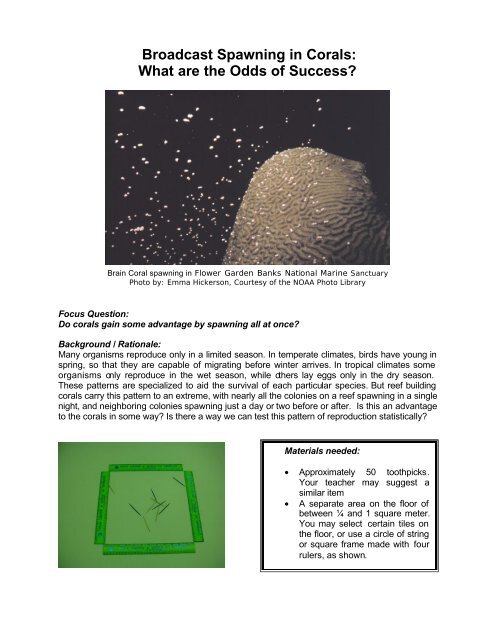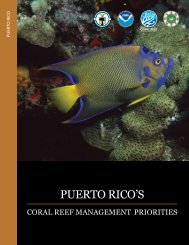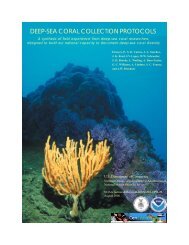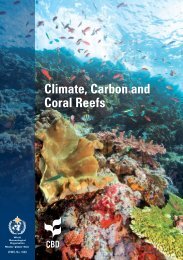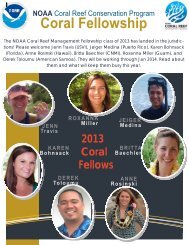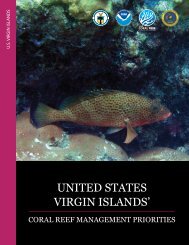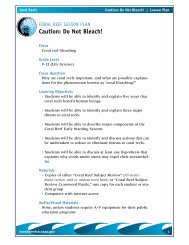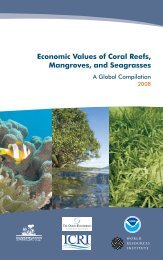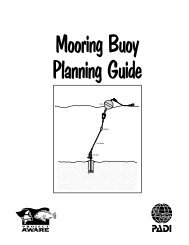Broadcast Spawning in Corals - NOAA's Coral Reef Conservation ...
Broadcast Spawning in Corals - NOAA's Coral Reef Conservation ...
Broadcast Spawning in Corals - NOAA's Coral Reef Conservation ...
You also want an ePaper? Increase the reach of your titles
YUMPU automatically turns print PDFs into web optimized ePapers that Google loves.
<strong>Broadcast</strong> <strong>Spawn<strong>in</strong>g</strong> <strong>in</strong> <strong><strong>Coral</strong>s</strong>:<br />
What are the Odds of Success?<br />
Bra<strong>in</strong> <strong>Coral</strong> spawn<strong>in</strong>g <strong>in</strong> Flower Garden Banks National Mar<strong>in</strong>e Sanctuary<br />
Photo by: Emma Hickerson, Courtesy of the NOAA Photo Library<br />
Focus Question:<br />
Do corals ga<strong>in</strong> some advantage by spawn<strong>in</strong>g all at once?<br />
Background / Rationale:<br />
Many organisms reproduce only <strong>in</strong> a limited season. In temperate climates, birds have young <strong>in</strong><br />
spr<strong>in</strong>g, so that they are capable of migrat<strong>in</strong>g before w<strong>in</strong>ter arrives. In tropical climates some<br />
organisms only reproduce <strong>in</strong> the wet season, while others lay eggs only <strong>in</strong> the dry season.<br />
These patterns are specialized to aid the survival of each particular species. But reef build<strong>in</strong>g<br />
corals carry this pattern to an extreme, with nearly all the colonies on a reef spawn<strong>in</strong>g <strong>in</strong> a s<strong>in</strong>gle<br />
night, and neighbor<strong>in</strong>g colonies spawn<strong>in</strong>g just a day or two before or after. Is this an advantage<br />
to the corals <strong>in</strong> some way? Is there a way we can test this pattern of reproduction statistically?<br />
Materials needed:<br />
• Approximately 50 toothpicks.<br />
Your teacher may suggest a<br />
similar item<br />
• A separate area on the floor of<br />
between ¼ and 1 square meter.<br />
You may select certa<strong>in</strong> tiles on<br />
the floor, or use a circle of str<strong>in</strong>g<br />
or square frame made with four<br />
rulers, as shown.
Student Activity:<br />
Select an area of the floor (or outside, if your teacher suggests it) to do your experiment. Mark<br />
off the study area <strong>in</strong> the form of a square or better yet, a circle. You will be do<strong>in</strong>g two series of<br />
trials, as described below. In both parts of the experiment, we are represent<strong>in</strong>g the potential<br />
reproduction of an equal number of coral colonies. In both parts, the same total number of<br />
gametes is released, but <strong>in</strong> the first part, the reproduction is spread out over five nights. In the<br />
second part, the reproduction occurs all <strong>in</strong> the same night.<br />
Part 1:<br />
The first series will represent spawn<strong>in</strong>g activity which is spread out over 5 nights. Scatter five of<br />
the toothpicks (or other objects suggested by your teacher) <strong>in</strong>side the study area. They<br />
represent five gametes (sperm or egg cells) that have been released by coral colonies <strong>in</strong>to the<br />
water at one time. Stand back, and toss the toothpicks one at a time <strong>in</strong>to the study area. Each<br />
time you toss a toothpick, record whether it strikes another toothpick or not, but leave it <strong>in</strong> the<br />
study area. Include any collision between any two toothpicks as a “fertilization,” even though we<br />
would normally identify only collisions between a male and a female gamete. When you are<br />
f<strong>in</strong>ished, pick up the five toothpicks you tossed <strong>in</strong>, and repeat the experiment. Keep track of the<br />
total number of fertilizations (toothpick collisions) <strong>in</strong> each of your five trials by record<strong>in</strong>g them <strong>in</strong><br />
the table below. This represents the potential reproductive success of corals which spawn over<br />
a five night period.<br />
Part 2:<br />
In the second series, place 25 of the toothpicks <strong>in</strong>side the study area. These represent corals<br />
that all spawn on the same night. Then one at a time, toss the rema<strong>in</strong><strong>in</strong>g 25 toothpicks <strong>in</strong>to the<br />
area, leav<strong>in</strong>g them where they land <strong>in</strong> the study area. Record the total number of times<br />
toothpicks collide <strong>in</strong> the table below.<br />
Trial: Trial 1 Trial 2 Trial 3 Trial 4 Trial 5 Total<br />
collisions<br />
Part 1<br />
Part 2 X X X X<br />
Analysis (You may need a separate sheet of paper):<br />
1. Which part of the experiment yielded the greater number of collisions? Try to expla<strong>in</strong><br />
why the number of collisions was not equal.<br />
2. If you repeated the experiment, would you expect exactly the same numbers? Expla<strong>in</strong><br />
why or why not.<br />
3. Based on this model, which mode of reproduction would be more successful for the<br />
corals, reproduction <strong>in</strong> a s<strong>in</strong>gle night or over a longer time?<br />
4. This model suggests that coral gametes only survive <strong>in</strong> the water for a s<strong>in</strong>gle night if they<br />
are unfertilized. How would results change if the gametes survived for a much longer<br />
period?<br />
5. Like most simplified models, this is a little unrealistic. What are some factors <strong>in</strong> the<br />
natural environment which affect the success of coral reproduction which are not<br />
accounted for <strong>in</strong> our model?
6. In the real world, predators will be try<strong>in</strong>g to eat as many of the gametes as possible.<br />
Which type of reproduction would be more successful if there is a predator <strong>in</strong> the area?<br />
Expla<strong>in</strong> why you th<strong>in</strong>k so.<br />
Conclusions:<br />
What general conclusions can you make from this experimental simulation? You may<br />
wish to make a list, show<strong>in</strong>g advantages and disadvantages of hav<strong>in</strong>g all the corals <strong>in</strong> a reef<br />
spawn <strong>in</strong> the same night.<br />
---------------------------------------------------------------------------------------------------------------------------<br />
For Teachers:<br />
Educational Objectives / National Science Standards supported by this lesson:<br />
Strand A (Science as Inquiry), Strand C (Life Science)<br />
Teach<strong>in</strong>g time / Sett<strong>in</strong>g:<br />
One period of 40 m<strong>in</strong>utes to an hour may be needed to complete the lab, <strong>in</strong>clud<strong>in</strong>g follow-up<br />
questions. Additional discussion about predators and other factors may be helpful to students.<br />
Students will need a lot of space to lay out study areas. Unless the classroom is large or has a<br />
lot of open space, you may need to use a hallway, gym floor, or perhaps do the exercise<br />
outside. If the area chosen is small enough, desktops may provide a large enough space.<br />
Suggestions:<br />
In lieu of toothpicks, paper clips, or any small object that won’t roll can be used. Co<strong>in</strong>s can be<br />
used, but will roll or bounce outside the study area frequently. Loops of str<strong>in</strong>g can be measured<br />
and tied off ahead of time for the study areas, so that all students have an equal sized study<br />
area. Additionally, it is helpful to collect class data and encourage students to compare their<br />
own data with others <strong>in</strong> the class.<br />
Analysis and Assessment:<br />
The questions provided should provide a good basis for assess<strong>in</strong>g students’ understand<strong>in</strong>g. In<br />
addition, you may wish to discuss concepts such as variability or repeatability of scientific data,<br />
and uncontrollable variables which create problems <strong>in</strong> field work (such as a school of fish which<br />
swims by, eat<strong>in</strong>g all the gametes they can hold).<br />
Follow-up / Extension Activities:<br />
This exercise can be used to <strong>in</strong>troduce many discussion topics on the nature of scientific<br />
<strong>in</strong>quiry, such as sample size, experimental error, and variability <strong>in</strong> results. This experiment can<br />
be done us<strong>in</strong>g pennies with heads represent<strong>in</strong>g one sex gamete and tails the other, further<br />
mak<strong>in</strong>g suggestions about reproductive success. In that case, only collisions result<strong>in</strong>g <strong>in</strong> one<br />
head and one tail would count as a fertilization. This should make results even more dramatic,<br />
and more realistic as well.<br />
References and Internet Resources:<br />
www.coralreef.noaa.gov This is NOAA’s <strong>Coral</strong> <strong>Reef</strong> Home page, with access to photos and a<br />
variety of sites related to coral reefs.<br />
http://www.reefs.org/library/article/coral_spawn<strong>in</strong>g.html An Article on coral spawn<strong>in</strong>g posted by<br />
the <strong>Reef</strong> Environmental Education Foundation. More l<strong>in</strong>ks can be found from REEF’s home<br />
page at www.reef.org.
http://www.gbrmpa.gov.au/corp_site/<strong>in</strong>fo_services/library/resources/reef_snapshots/coral_spaw<br />
n<strong>in</strong>g.html An Australian site with photos of spawn<strong>in</strong>g corals.<br />
http://www.coralreef.noaa.gov/ <strong>NOAA's</strong> <strong>Coral</strong> <strong>Reef</strong> onl<strong>in</strong>e. Here you will f<strong>in</strong>d the latest news on<br />
coral reefs as well as l<strong>in</strong>ks to the various NOAA web sites with additional <strong>in</strong>formation<br />
http://www.coris.noaa.gov/about/welcome.html <strong>NOAA's</strong> <strong>Coral</strong> <strong>Reef</strong> Information System website<br />
about coral reefs.


